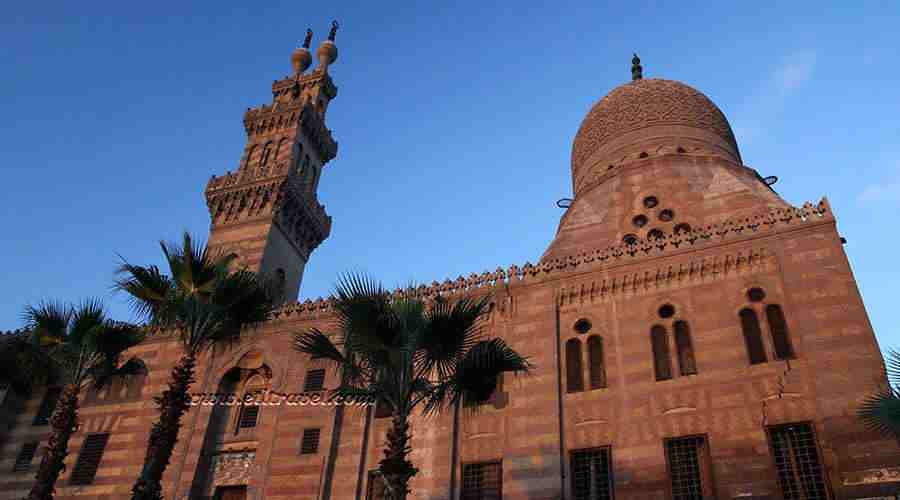Qanibay Amir Akhur Complex Cairo Egypt tours, prices, booking
Qanibay Amir Akhur complex Cairo belongs to Qanibay Al Sayfi. In fact, he was grand master of the horses during the reign of Sultan Al Ghuri. He also known as Al-Rammah because he was famous for his horsemanship and using spears. Al Rammah is an Arabic word means the lancer. Qanibay Amir Akhur complex sometimes known as madrasa of Qanibay Qura Al Rammah. In fact, it features a madrasa, mosque and a Sabil-Kuttab. The Mamluk era varied creative features to the already diverse and expressive Islamic Architecture. Moreover, Mamluk early buildings followed the traditional plans and designs. The Islamic architectural reached its most significant achievements during the Mamluk time. The complex built in 1503 AD in Cairo. It built on a hill overlooking Sultan Hassan mosque and Al Rifai mosque.
Qanibay Amir Akhur complex indeed has a unique location. It lies in Salah El Din Square opposite Bab Al Azab. Baba Ala Azab is one of the city gates. This gate lies next to the Horse market. Moreover, it leads to the Sultans horse stables. It located in the citadel grounds just off the square. The important complexes usually built on main streets. Designers often faced with most irregular plots of land. Creative architectural solutions required to do a successful building. One of these cases seen in the Qanibay madrasa. It built on stepped rocky ground. This conflict overcame by erecting the complex on storerooms and the madrasa basement. That is why the various parts of the facade would be at the same height.
Further details about Qanibay Amir Akhur complex Cairo Egypt:
It took full advantage of the view and at the same time exposing the mosque to the crowds below. For this reason, the building considered a suspended mosque. The mosque and madrasa occupy the upper floor while the Sabil is on the left of the entrance. It is above which located the Kuttab. Moreover, the mosque and madrasa reached by an exterior staircase. It is on the main south eastern facade. And then through a trilobed vaulted portal. Qanibay Amir Akhur complex has a long main facade overlooking the square. It consists of the same elements used in Mamluk architecture . They are such as rectangular niches that differ according to the function behind them.
Furthermore, the rectangular niche of the entrance has two sitting decks on the sides. It topped with calligraphic bands. It composed of a trilobed arch crowned by another taking the shape of trefoil leaves. As for the rectangular niche of the qibla iwan, it has two windows in each. The Sabil facade consists of a large rectangular window. It surmounted by four small wooden window screens. Qanibay Amir Akhur complex has a bent entrance leading to a vestibule. It isolating it from the exterior and working as a distribution space to all the elements of the complex. The vestibule has a beautiful wooden ceiling supported on stalactite frieze with colored ornaments.
Further details about Amir Akhur complex Cairo Egypt:
In fact, the madrasa follows the traditional Qaa plan. Moreover, it marked for the extravagance and richness of its interior golden decorations. It composed of an open central Durqaa (hall). Furthermore, it surrounded by two perpendicular Iwans and another two side ones. Facing the Qibla Iwan, is a stone Mihrab. It worked with various ornaments, a wooden Minbar and two bands of Quranic inscriptions. The Qibla Iwan roofed by a shallow vault on pendentives. The Iwan on the opposite side covered by a cross vault. Limestone used for building external and inner walls of the madrasa. The mausoleum occupies the corner of the adjacent building to the Qibla Iwan. It can reached from the Durqaa through the southeast door. The internal walls cl-added with marble and it has a Mihrab facing it with two side wall cupboards.
The mausoleum dome rests on four pendentives decorated. It is with seven rows of Muqarnas (stalactites). It is also with a drum containing sixteen arched windows topped by the calligraphic text. This dome has amazing arabesque carving patterns and floral forms seen from the outside. The minaret, located to the left of the entrance as a landmark. It consists of two pedestals. They are one on top of the other separated by rows of stone Muqarnas which carry the balconies. This minaret is a style that appeared in the end of the Mamluk era. It is the oldest of its kind. It is a twin-topped minaret rather than the usual one head. The double type minarets also used afterwards in Al Ghouri Mosque and Al Azhar Mosque.
More details about Qanibay Amir Akhur complex in Cairo Egypt:
Qanibay Amir Akhur complex minaret has a square lower and middle section. The upper section composed of two rectangular bodies with an arched recess on each side. Both surmounted by a Mamluk dome ending with a post. They crowned by a spherical bulb form domes and crescent. Prince Qanibay Qura Al Rammah known to be fond of architecture and construction. He also built a madrasa in Al Naseriyya. Prince Qanibay died in 1515 A.D. He buried in the madrasa at the complex. In fact, the complex first restored in 1895. And then in 1939 by the French Commission for the conservation of Arab Monuments.














